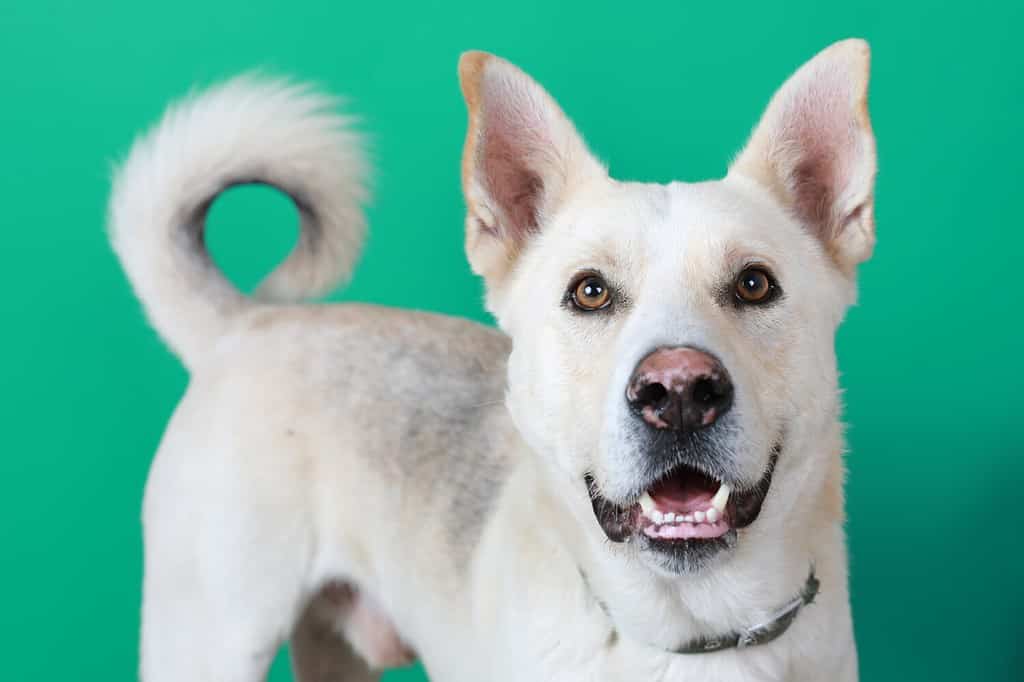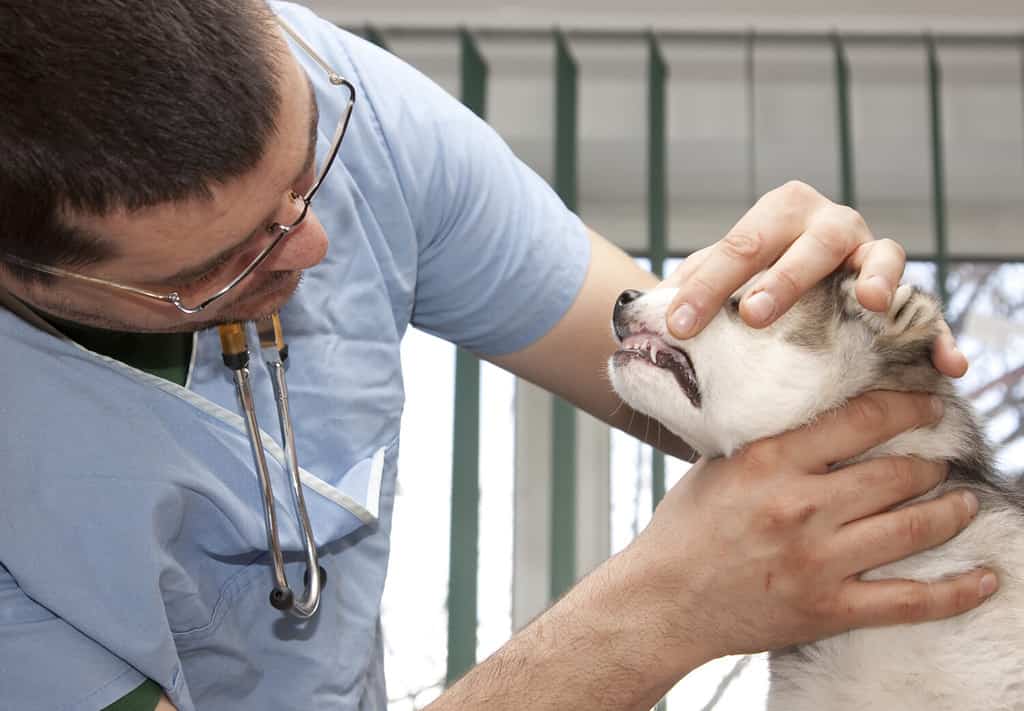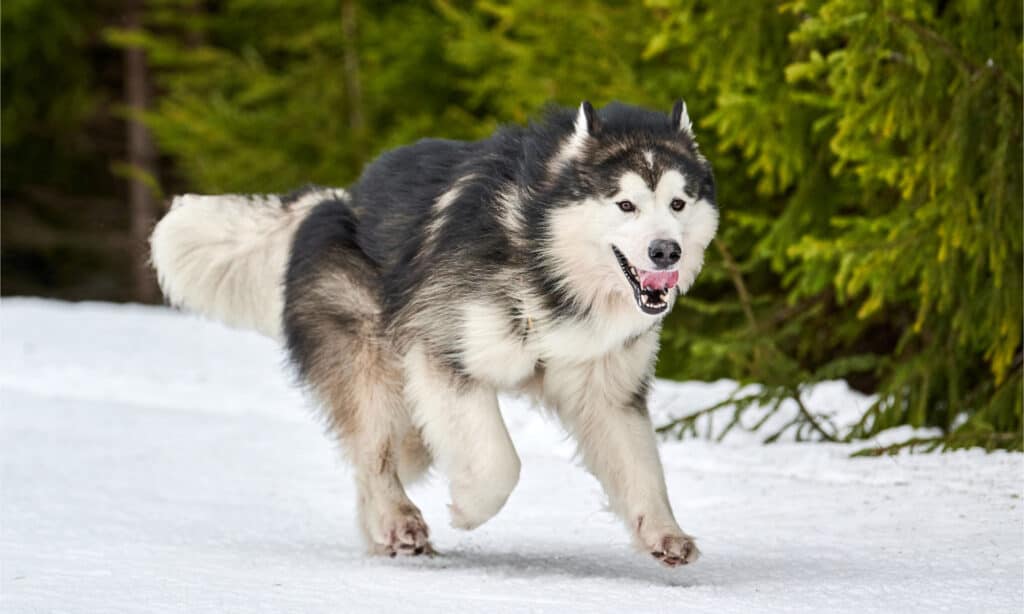A Labrador husky is an unusual pet because it’s not what most people think. Labrador huskies are not a cross between a Labrador dog and a husky dog but a pure breed in its own right. It’s a husky-type breed from Labrador, Canada. It’s so rare the American Kennel Club doesn’t yet accept registrations. A Labrador-husky cross is a huskador or a labsky. With that cleared up, let’s take a look at Labrador husky progression: growth, milestones, and training tips.

Labrador huskies excel in search and rescue and drug detection.
©Bernard Khalil/Shutterstock.com
Labrador Husky: Summary
They are active dogs developed to pull sleds in cold weather and maintain friendly relationships with handlers and other dogs in the team. Historically, wolves were part of the breed’s ancestry because wolf DNA increased their endurance in cold, snowy conditions and helped build a pack mentality. Today, Labrador huskies excel in search and rescue and drug detection.
As a result, Labrador huskies are powerful dogs that need plenty of exercise and companionship. It’s certainly not a dog that will enjoy solitude and rest for long. These beautiful dogs’ proportions are classic husky-wolf with long legs and a wide chest.
A tall breed, Labrador huskies stand 28 inches at the withers, and males can reach 100 pounds. Their heads appear round yet pointed, with pricked-up ears and a long, narrow muzzle. Due to their cold conditions breeding, Labrador huskies have thick double coats in a range of colors from white, grey, black, and red. Webbed paws help them move fast in deep snow.
Although rare, they are handsome dogs and have a cult following of devotees who fall in love with their wolfy looks and strong work ethic.
Let’s look at Labrador Husky’s progression: growth, milestones, and training tips to better understand this unusual breed.

Because this is a big dog, Labrador husky progression, such as growth, milestones, and learning training tips, are important to help keep control.
©Christopher Teixeira/Shutterstock.com
Labrador Husky: Growth and Weight
Labrador huskies are large, powerful dogs that reach 28 inches at the withers. Males are chiefly larger than females, but here’s what you’d typically expect:
One-month-old pups weigh around 5-6 lbs, but by the time they reach six months, males can weigh over 40 lbs and females a little less. At a year old, male Labrador huskies weigh around 60 lbs, and females around 50 lbs.
By two years old, Labrador huskies have usually stopped growing and weigh 60-90lbs with males at the heavier end of the scale. Some male Labrador huskies reach 100 lbs.
Individual dogs vary, but if a Labrador husky is eating the correct food and exercising regularly, owners should not feel alarmed if weight varies from this pattern. A veterinarian experienced with active breeds is the best port of call if you have concerns over your Labrador husky’s weight or growth.
When Will My Labrador Husky Stop Growing?
Labrador huskies reach their full height and weight by two years old and start to slow down at 15 months. There’s variation between individual dogs, so regular vet checks can ensure your dog grows at a healthy rate.
Labrador huskies should have access to water 24/7 and receive the right amount of food for their age. Pups need three meals a day of high-quality puppy food and begin to switch to adult food at around six months old to support their rapid growth.
Adult Labrador huskies should eat once or twice a day and may need more than the recommended amount if they are active. All commercial brands vary, so read the packet guidelines and feed accordingly.
If you can feel a Labrador husky’s rib bones, they likely need more food. Six monthly vet check-ups for an adult will indicate whether their weight is suitable and what you can do to help manage it, but address any concerns sooner in case your dog has a medical issue.
How Big Will My Labrador Husky Be When It’s Fully Grown?
Labrador huskies are large, strong dogs capable of withstanding snowy conditions and hours of hard work. A male Labrador husky reaches around 28 inches at the withers, and females reach 26 inches.
Heavier males can weigh between 60-90 pounds and females 50-80 pounds, but this is an estimate, and individuals vary due to genetics or activity levels.
Because this is a big dog, Labrador husky progression, such as growth, milestones, and learning training tips, are important to help keep control.
When Should My Labrador Husky Be Spayed or Neutered?
In general, sprayed or neutered dogs remain healthier than un-neutered or spayed ones. Most vets recommend neutering or spaying between 6-9 months old, but it varies with individual dogs, so it’s best to take vet advice.
Neutering and spaying dogs can help in the following ways:
- No accidental pregnancy
- Calmer, more placid temperament
- Less desire to roam
- Stops spraying
- Fewer uterine infections
- Decreases breast tumor likelihood
When Should My Labrador Husky Be House Broken?
Clever labrador husky house training should start the moment they arrive home. To start with, take the pup to the same spot in your yard after eating and before bedtime to encourage a pattern. As they grow, praise and reward toileting outside.
Labrador huskies love people and interaction, but when it’s time for the toilet, they prefer some privacy. Don’t stare. Just turn away or hover nearby.
With all the best intentions, accidents happen, and it’s best to remain calm if a young dog toilets in the home. Simply take them outside straight away to their toileting spot.
If a Labrador husky toilets in the house frequently, despite regular training and encouragement, a vet check-up is necessary to rule out infections or other medical issues.
All dogs progress at different rates, but Labrador huskies are clever and eager to please, so consistent, patient toilet training doesn’t take long. After a week, clever pups understand what’s required of them, but lazier pups may take longer!
When Should My Labrador Husky Stop Eating Puppy Food?
When they reach around six months old, Labrador husky dogs begin transferring to adult dog food, but it’s important to take vet advice because switching too early or late may impact their health.
Pups and adults need different nutrition to support healthy growth. Too little puppy food may lead to weak bones, but too much and an adult dog won’t get the nutrients required to grow a healthy, strong adult body.
A period of transition is required to ensure growth and development goes smoothly. To avoid gastrointestinal issues, mix a small amount of adult food into your pup’s food and increase it over 2-3 weeks.
When Will My Labrador Husky Start Losing Teeth?
Losing teeth is a real puppy milestone!
Labrador huskies are a rare breed, and there isn’t much information about their traits. However, some vets suggest they lose teeth at the same rate as other northern breed sled dogs, which is as follows:
- Incisors emerge: three months
- Pre molars and canines emerge: four months
- Adult molars emerge: six-seven months
During this time, a Labrador husky puppy may want to chew to relieve soreness and itching. Here’s how we can help them:
- Frozen hand towel: Drench a hand towel and put it in the freezer. When the pup chews it, ice will reduce inflammation and soreness. However, it’s important to supervise chewing because small parts of ingested hand towels may cause an intestinal blockage.
- Rope toy: A good quality rope toy helps relieve itching and saves furniture. Ensure the toy is a quality brand so bits don’t break off. Again, supervise your pup’s chewing time.
- Ice cubes: Crunchy ice cubes make a fun treat for dogs in the hot months, and they help reduce teething inflammation.
- Frozen treats: Freeze a carrot to provide a healthy, low-calorie teething toy

A Labrador husky puppy may want to chew to relieve soreness and itching.
©Melinda Nagy/Shutterstock.com
When Should I Start Training My Labrador Husky?
Clever Labrador huskies love to learn. Training should begin as soon as they arrive home to establish good habits and ensure you have control over these large, powerful dogs.
Search and rescue teams and crime prevention professionals use Labrador huskies because their work ethic is high, and they can put in strenuous work. While they are not common working professional dogs outside of sledding, they are excellent workers, and this makes them easy to train at home.
Dog training a Labrador husky is about consistent “learn and reward” tasks. Use treats, praise, or play to reward the correct behavior. Lab huskies cotton on within minutes. Start when your puppy arrives home, or if you adopt, as soon as you’re in the door. It’s never too early to train, but consider that young pups tire out quickly; don’t push training on them if it’s clear they need to rest.
What Commands Should I Teach My Labrador Husky First?
Essential training tips for Labrador huskies include recall, sit, stay, and come. Once mastered, move on to agility, such as rollover and jumping.
The best way to learn the sit command is to speak the cue “sit” and press gently on their withers. When the dog sits, instantly reward them with a treat. And repeat. A Labrador husky will not take many tries to understand that “sit” means treats. Eventually, the command is enough on its own.
Pack dog Labrador huskies need a leader to work for, and that must be you, or their behavior may get out of control. Positive reinforcement is the best way to train any type of dog. Dominance training can cause behavioral problems, so don’t punish your dog.

The best way to learn the sit command is to speak the cue “sit” and press gently on their withers.
©Bernard Khalil/Shutterstock.com
When Will My Labrador Husky Calm Down?
Young Labrador husky dogs calm down as they approach adulthood, which is around 15 months to two years. However, due to their breed’s working genetics, Labrador huskies need lots of exercise and entertainment, or they may become destructive and badly behaved.
Consistent training, exercise, and a healthy, nutritious diet help calm down all breeds of dogs, along with spaying and neutering in some cases.
Other Dog Breeds Similar to Labrador Husky
We’ve learned about Labrador husky progression, growth, milestones, and training tips, but Labrador huskies are rare breeds outside of their native region. Here are three similar breeds:
Husky
Clever Siberian husky dogs are similar to Labrador huskies. Both are sled dogs bred to work hard in a pack. They have similar coats, training, and exercise requirements.
Malamute
Like Labrador huskies, Alaskan malamutes were bred to pull sleds and cope with freezing temperatures.

Alaskan Malamutes have thick, fluffy coats that provide excellent insulation against the cold.
©travelarium.ph/Shutterstock.com
Chinook
100-pound chinook sled dogs pull sleds in polar regions. They are intelligent and friendly, just like Labrador huskies, but they look different with their floppy ears and red coats.
The photo featured at the top of this post is © Christopher Teixeira/Shutterstock.com
Ready to discover the top 10 cutest dog breeds in the entire world?
How about the fastest dogs, the largest dogs and those that are -- quite frankly -- just the kindest dogs on the planet? Each day, AZ Animals sends out lists just like this to our thousands of email subscribers. And the best part? It's FREE. Join today by entering your email below.
Thank you for reading! Have some feedback for us? Contact the AZ Animals editorial team.






